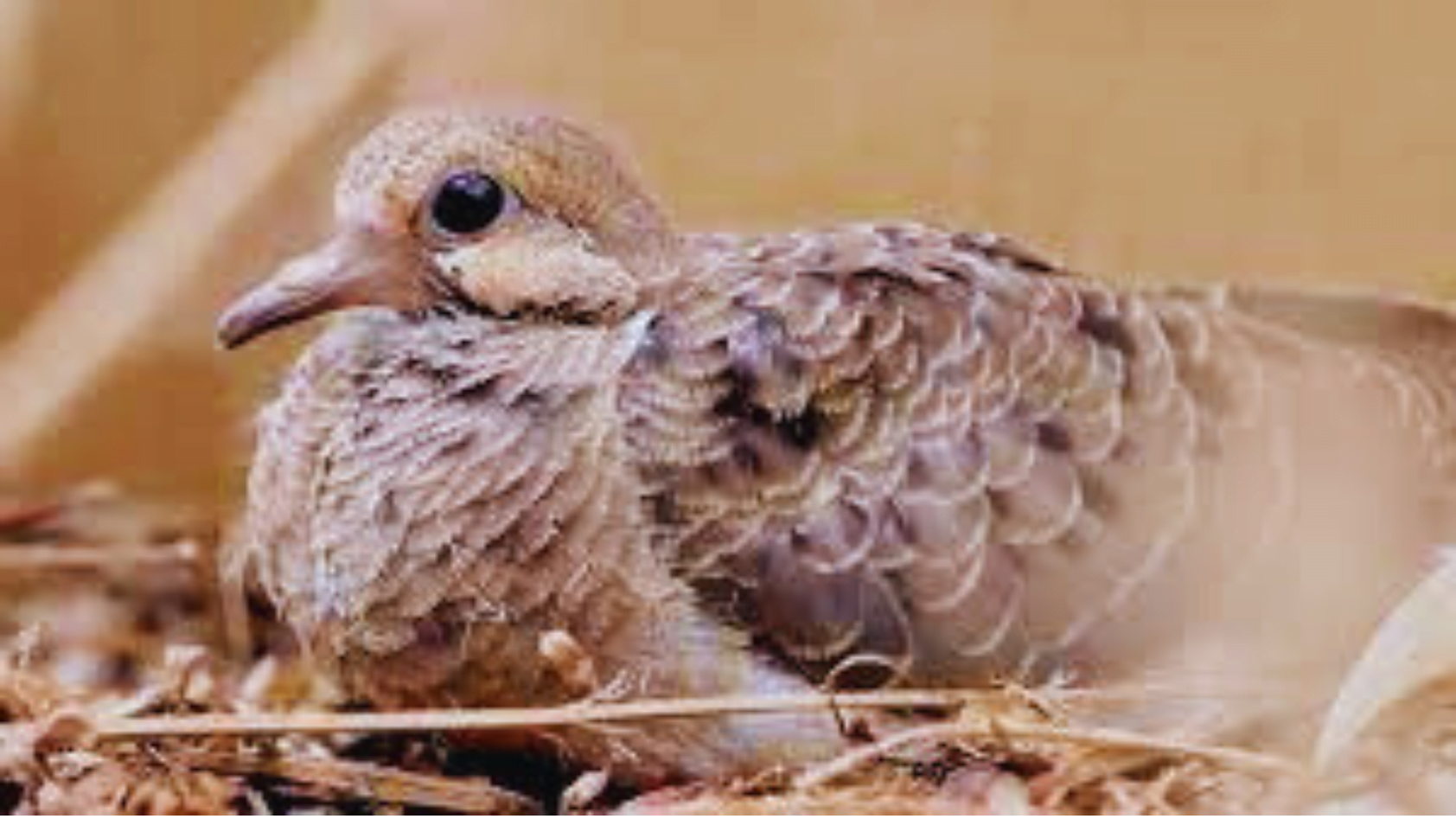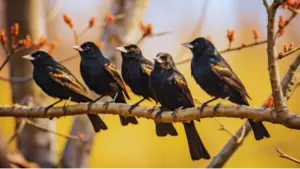Where Do Mourning Doves Sleep? Discover the fascinating sleeping habits of mourning doves and find out where these gentle birds rest during the night.
Do you know that mourning doves, those peaceful birds that grace your backyard, have a fascinating roosting behavior? These gentle creatures have a unique way of finding cozy sleeping spots each night.
In fact, did you know that mourning doves can sleep with one eye open, allowing them to stay alert to potential dangers while still getting some rest? This incredible adaptation ensures their safety and survival in the wild.
In this article, we will delve into the natural habitat of mourning doves and explore their roosting habits in detail. We will also discuss the importance of safety and security in their choice of roosting locations.
Additionally, we will uncover how these birds adapt to urban environments and examine their roosting habits during the breeding season. By understanding the role of roosting in conservation efforts, we can learn how to create a dove-friendly roosting environment.
So, grab a cup of coffee, sit back, and let’s appreciate the beauty and serenity of mourning doves’ cozy roosting habits together.
Key Takeaways
- Mourning doves have unique roosting behaviors, including sleeping with one eye open and choosing roosting locations based on shelter, food, and perching options.
- Factors influencing roosting spot selection include preference for trees, dense foliage, and evergreen trees, as well as protection, camouflage, shelter, and concealment.
- Roosting behavior plays a crucial role during the breeding season, with nests being made in trees, shrubs, or man-made structures, and sleeping on the ground helping protect eggs.
- In urban environments, mourning doves adapt by roosting on ledges, window sills, and air conditioning units, balancing on narrow surfaces using strong claws, and sleeping with their eyes partially open to remain alert.
The Natural Habitat of Mourning Doves
Mourning doves can be found in a variety of natural habitats. One common habitat is open woodlands, which offer a combination of trees for roosting and open spaces for foraging. In these areas, the doves can easily find shelter and food.
Mourning doves also enjoy urban areas with tall trees and parks. These places provide them with a variety of perching options, such as rooftops, power lines, and tree branches. They are adaptable birds and can easily make themselves at home in these man-made environments.
Another natural habitat for mourning doves is agricultural land. They are often seen perched on fences or power lines near fields, where they can access food sources like grains and seeds. The wide, open spaces of farmland also provide them with ample room to fly and explore.
Overall, mourning doves are versatile when it comes to choosing their roosting locations. Whether it’s in open woodlands, urban areas, or agricultural land, these peaceful birds can find a cozy spot to rest and sleep.
A Look Into Their Roosting Behavior
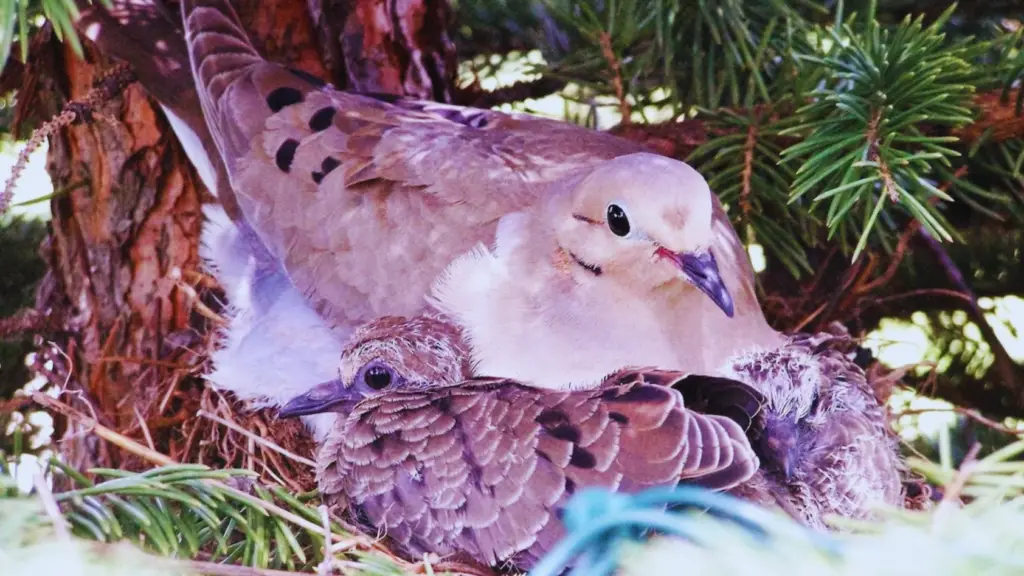
Resting in the tranquil embrace of twilight, these gentle creatures find solace in the safety and warmth of their nocturnal abode. Mourning doves, with their peaceful nature, have unique roosting behaviors that allow them to find comfort and security during the night.
These birds prefer roosting in trees, often in dense foliage or evergreen trees. They choose locations that provide protection from predators and harsh weather conditions. Mourning doves are not known for building elaborate nests like other bird species, instead, they tend to rest on sturdy branches or in the forks of trees. This simple roosting behavior allows them to easily blend in with their surroundings, making it harder for predators to spot them.
To better understand their roosting habits, let’s take a look at a table that showcases the different places mourning doves choose as their sleeping quarters:
| Location | Description | Benefits |
|---|---|---|
| Trees | Sturdy branches or forks | Protection, camouflage |
| Dense foliage | Thick leaves and branches | Shelter, privacy |
| Evergreen trees | Year-round greenery, dense branches | Concealment, protection from elements |
As the night falls, these peaceful birds find comfort in their chosen roosting spots, where they can sleep undisturbed until the morning sun welcomes a new day. So next time you see a mourning dove perched in a tree, remember that it has carefully selected that spot to ensure a peaceful night’s rest.
The Importance of Safety and Security
When seeking solace at night, it’s crucial to prioritize safety and security. Mourning doves understand this instinctively, and they choose their roosting spots with great care. Here are some reasons why safety and security are so important to them:
- Protection from predators: Mourning doves are vulnerable to a variety of predators, including hawks, owls, and snakes. By roosting in dense vegetation or high up in trees, they can minimize the risk of being spotted and attacked.
- Shelter from the elements: By finding a secure roosting spot, mourning doves can protect themselves from harsh weather conditions such as strong winds, heavy rain, or extreme temperatures. This allows them to conserve energy and stay comfortable throughout the night.
- Privacy and seclusion: Mourning doves prefer quiet and peaceful surroundings for their nightly rest. By choosing a safe roosting spot, they can avoid disturbances from humans, other animals, or even their own kind. This privacy allows them to recharge and prepare for the challenges of the upcoming day.
- A sense of belonging: By roosting in a secure location, mourning doves can establish a sense of belonging and familiarity. This helps them feel more at ease and contributes to their overall well-being.
In conclusion, safety and security play a vital role in the roosting habits of mourning doves. By prioritizing these aspects, these peaceful birds can find solace and tranquility in their cozy sleeping spots.
Urban Roosting: How Mourning Doves Adapt
Nestled in the concrete jungle, these gentle creatures find solace in the urban chaos, adapting to the cacophony of city life. Mourning doves have mastered the art of urban roosting, making use of the various structures and resources available to them in their quest for a cozy sleep.
Unlike their rural counterparts, who prefer to roost in trees or on the ground, urban mourning doves have learned to take advantage of the man-made structures that surround them.
You can often find these peaceful birds perched on ledges, window sills, or even on top of air conditioning units. They have a remarkable ability to balance on narrow surfaces, using their strong claws to hold on tightly. This enables them to sleep comfortably and securely, even in the midst of a bustling city.
Mourning doves have also adapted to the bright lights and noise pollution of urban areas. They are able to sleep with their eyes partially open, which allows them to remain alert and aware of their surroundings. This ensures their safety and helps them avoid potential predators.
So, next time you find yourself walking through the busy streets of the city, take a moment to appreciate the resilience and adaptability of these peaceful birds. Despite the chaos and constant movement, they have found their own peaceful corner in the urban landscape, demonstrating that even in the midst of chaos, solace can be found.
Roosting Habits During Breeding Season
Find solace in the urban chaos by appreciating the way these gentle creatures adapt their roosting habits during breeding season. Mourning doves, known for their peaceful nature, make their nests in a variety of locations, often choosing trees, shrubs, or even man-made structures like rooftops or balconies. Both the male and female typically work together to build their nests, which they line with grass, twigs, and other materials to make a cozy place for their eggs.
During the breeding season, mourning doves exhibit a unique roosting behavior. Unlike other birds that tend to sleep in their nests, mourning doves actually sleep on the ground. They find a safe spot on the grass or in low shrubs, huddling close to the ground for protection. This behavior helps them stay hidden from predators and also keeps their eggs safe from potential harm.
In urban areas, mourning doves have adapted to roosting on ledges, window sills, and other elevated structures. These elevated roosting spots provide them with a sense of security and allow them to keep an eye out for any potential threats. Additionally, the warmth radiating from buildings can provide them with extra comfort during the colder nights of the breeding season.
By observing and appreciating the roosting habits of mourning doves during the breeding season, you can gain a deeper understanding of their remarkable ability to adapt and find solace amidst the bustling urban environment.
Roosting Habits During Migration
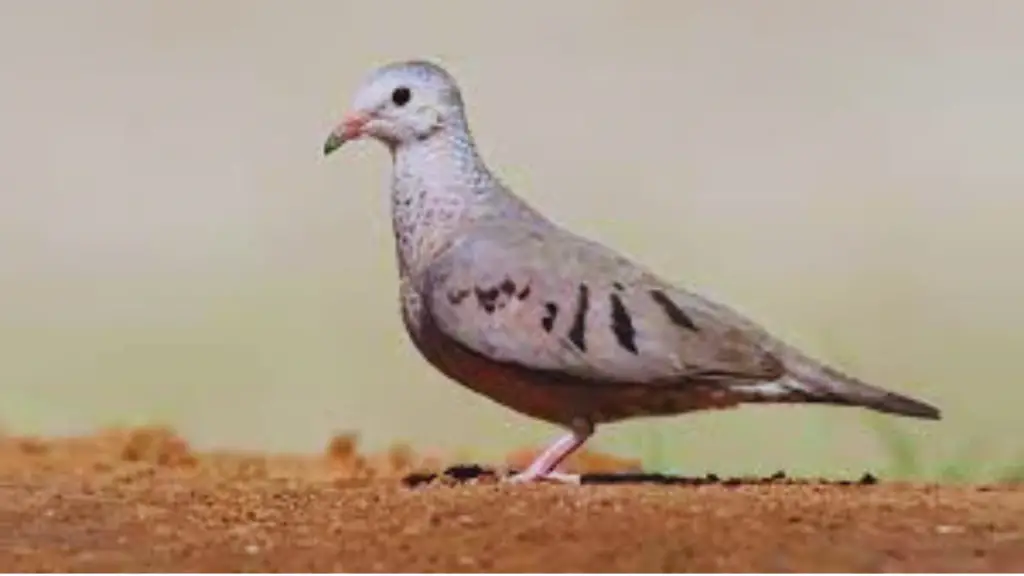
As migration approaches, these resilient creatures seek refuge in remote locations, seeking shelter and safety during their incredible journey. Mourning doves have a unique roosting habit during migration, that differs from their breeding season roosting habits. Here are three key aspects of their roosting behavior during migration:
- Group roosting: During migration, mourning doves often roost in large flocks, sometimes consisting of hundreds or even thousands of birds. This behavior provides them with safety in numbers, as they can alert each other to potential dangers and predators.
- Preferred habitat: Mourning doves prefer roosting in dense shrubs, trees, or even tall grasses during migration. These locations offer them protection from harsh weather conditions and predators, while also providing a comfortable and cozy environment to rest in.
- Nocturnal roosting: Unlike their diurnal roosting habits during the breeding season, mourning doves tend to roost primarily at night during migration. This allows them to conserve energy during the day for their long and arduous journey.
By understanding these roosting habits during migration, we can appreciate the incredible resilience and adaptability of mourning doves. As they embark on their journey, they find solace in these remote locations, ensuring their safety and well-being as they travel long distances in search of favorable habitats.
Communal Roosting: Strength in Numbers
Gathered together in a grand display of unity, these resilient creatures find strength in their numbers as they roost communally during migration. Mourning doves, known for their peaceful nature, seek comfort and safety in the company of others. As the sun sets, they gather in large flocks, settling into trees or shrubs for the night.
Communal roosting provides several advantages for these birds. By roosting together, they can share warmth and conserve energy. Each bird stays warm throughout the chilly nights thanks to the collective body heat the group produces. Additionally, being part of a larger group provides protection against predators. More eyes and ears mean a higher chance of detecting danger and alerting others.
The choice of roosting locations also plays a crucial role in their communal sleeping habits. Mourning doves often opt for dense vegetation, such as evergreen trees or dense shrubs. These locations offer both shelter and camouflage, making it harder for predators to spot them.
While communal roosting is common during migration, mourning doves also display this behavior outside of the migratory season. During the colder months, they may gather in groups to roost together, finding comfort in the presence of their fellow doves.
In conclusion, the communal roosting habits of mourning doves exemplify their ability to find strength in numbers. By coming together, these peaceful birds ensure their safety, conserve energy, and create a sense of unity within their flock.
The Role of Roosting in Conservation
Imagine yourself surrounded by a multitude of resilient creatures, seeking comfort and safety in their communal roosting habits as they come together to conserve energy and protect against predators. Mourning doves, with their peaceful demeanor, also play a crucial role in conservation through their roosting behavior.
Here are three fascinating aspects of the role of roosting in conservation:
- Energy Conservation: By roosting together in large groups, mourning doves can conserve energy during cold nights. By huddling together, they minimize heat loss and reduce the energy needed to maintain their body temperature. This energy-saving strategy allows them to allocate more energy for other essential activities such as foraging and reproduction.
- Predator Protection: Roosting in groups provides mourning doves with safety in numbers. By sleeping together, they can keep a watchful eye on predators and quickly alert each other to potential threats. This collective vigilance increases their chances of survival and reduces the risk of predation.
- Social Bonding: Roosting in communal groups also fosters social bonding among mourning doves. By spending time together in close proximity, they can strengthen social ties, form lasting partnerships, and enhance overall group cohesion. This social aspect of roosting contributes to the overall well-being and success of the species.
In conclusion, the roosting behavior of mourning doves serves not only as a means of protection and energy conservation but also as a way to strengthen social bonds within their community. Next time you see a group of mourning doves huddled together, remember the important role they play in conservation.
Creating a Dove-Friendly Roosting Environment
Creating a dove-friendly roosting environment involves providing suitable nesting sites and ensuring the availability of food and water sources. When it comes to nesting, mourning doves prefer to build their nests in trees, shrubs, or on man-made structures like ledges or rooftops. They look for places that provide protection from predators and the elements. To attract mourning doves to your property, consider planting native trees and shrubs that can provide suitable nesting sites. Additionally, you can install nesting platforms or boxes at various heights to accommodate their nesting preferences.
In terms of food and water sources, mourning doves primarily feed on seeds. Providing a diverse range of seed-bearing plants in your garden or providing bird feeders that dispense seeds can help attract these peaceful birds. It’s important to keep the feeders clean and filled regularly to ensure a constant food supply. Mourning doves also require access to fresh water for drinking and bathing. You can set up a shallow birdbath or a water feature with a gentle drip or fountain to provide a source of clean water for them.
By creating a dove-friendly roosting environment with suitable nesting sites, abundant food sources, and fresh water, you can help support the population of these peaceful birds in your area.
| Nesting Sites | Food Sources | Water Sources |
|---|---|---|
| Trees and shrubs | Seed-bearing plants | Birdbaths |
| Man-made structures | Bird feeders | Water features |
| Nesting platforms/boxes |
Observing Mourning Doves in Their Roosting Spots
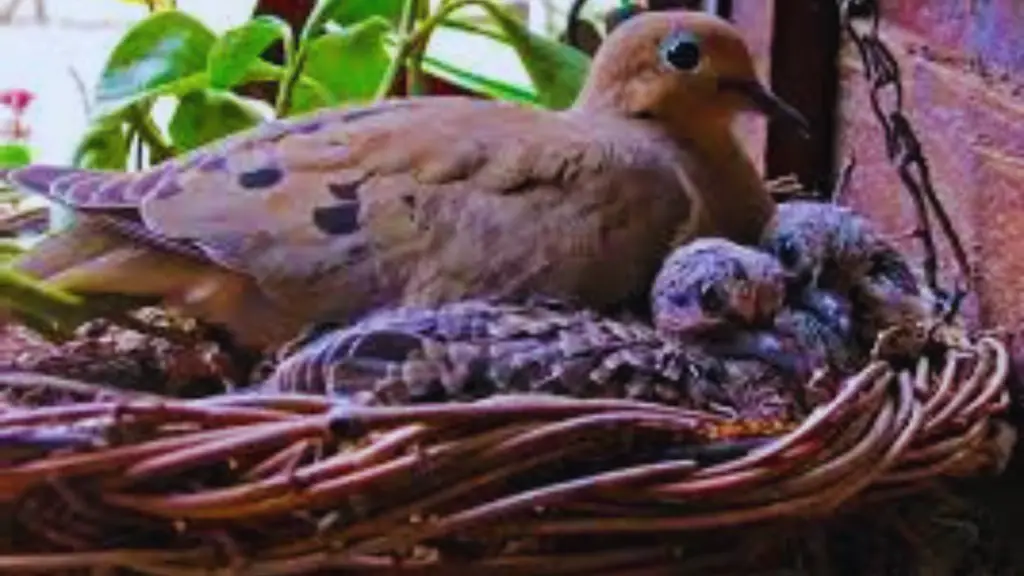
Now that you’ve created a dove-friendly roosting environment, it’s time to sit back and observe the peaceful mourning doves in their natural habitat.
As you take a moment to watch, you’ll be amazed at their roosting spots and habits.
Mourning doves are known for their preference for cozy sleeping quarters. They often choose to roost in trees, particularly conifers or deciduous trees with dense foliage. These locations provide them with protection from predators and the elements, allowing them to rest undisturbed.
You may notice that mourning doves have a unique way of roosting. Instead of settling on a branch, they perch on it, with their feet tightly gripping the branch. This secure grip ensures their safety while they sleep, even during windy nights.
Keep an eye out for these beautiful birds in your observations. You might spot them roosting alone, or in small groups, huddled close together for warmth and companionship. Their soft cooing calls may also fill the air as they communicate with one another.
Observing mourning doves in their roosting spots allows you to witness their peaceful nature firsthand. It’s a truly serene experience that will deepen your appreciation for these gentle birds and their cozy sleeping habits.
Appreciating the Beauty and Serenity of Mourning Doves’ Roosting Habits
Witnessing the serene and breathtaking roosting habits of mourning doves is sure to fill you with awe and tranquility. As you gaze upon these peaceful birds, you can’t help but appreciate the beauty that surrounds them.
Mourning doves have a unique way of finding their roosting spots. They prefer to sleep in trees, often perched on branches that provide a safe and comfortable resting place. Their cooing calls can be heard as they settle in for the night, a soothing melody that echoes through the stillness of the evening.
These birds are known for their gentle and calm nature, and this is evident in their roosting habits. They tuck their heads under their wings, creating a cozy and secure space for themselves. It’s a sight that is both charming and heartwarming, a reminder of the tranquility that can be found in nature.
As the night falls, the mourning doves find solace in their roosting spots, creating a serene atmosphere that is truly enchanting. The soft rustling of leaves and the gentle flapping of wings create a symphony of peacefulness. It’s a moment to pause and appreciate the simple beauty that exists in the world around us.
So, take a moment to observe the roosting habits of mourning doves. Let their serenity and tranquility wash over you, filling your heart with a sense of calm. These birds are a reminder that even in the busiest of lives, there is always a place for peace and beauty.
Where Do Mourning Doves Sleep: FAQs
How many hours do mourning doves typically sleep each night?
Mourning doves sleep peacefully for about 8 hours each night, just like a contented baby in a cradle. They find comfort in roosting on tree branches, while keeping a watchful eye for predators.
What is the lifespan of a mourning dove?
The lifespan of a mourning dove is typically 1-3 years. They have been known to live up to 5 years in the wild, but most do not survive beyond their first year.
Do mourning doves prefer to roost alone or in groups?
Mourning doves prefer to roost alone, finding solace in their own company. They seek out secluded spots, like trees or shrubs, where they can rest undisturbed and find comfort in their peaceful solitude.
How do mourning doves choose their roosting spots?
You’ll be surprised to learn that mourning doves choose their roosting spots based on a combination of factors, including safety, comfort, and availability of food. Let’s dive into the fascinating world of these peaceful birds.
Are mourning doves affected by light pollution in urban areas?
Mourning doves can be affected by light pollution in urban areas. The bright lights can disrupt their sleep patterns and make it difficult for them to find suitable roosting spots.
Conclusion
Congratulations on completing your journey into the tranquil world of mourning doves’ roosting habits! You’ve discovered the hidden sanctuaries where these peaceful birds find solace and rest.
By understanding their roosting behavior, you’ve unlocked the key to their safety and security. Witnessing these majestic creatures in their cozy roosts is truly a sight to behold.
So, embrace the beauty and serenity of their roosting spots, and let the euphoria of their presence fill your heart. May you continue to appreciate and protect these gentle guardians of the sky.

